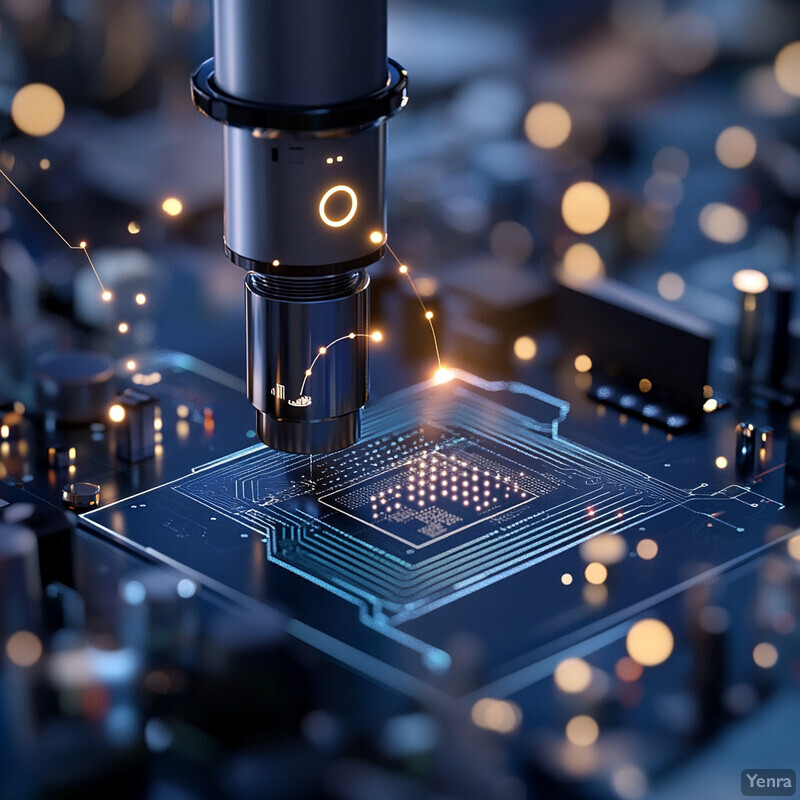1. Intelligent Resource Allocation
Intelligent Resource Allocation uses AI to dynamically distribute computing, storage, and networking resources across edge nodes according to real-time demand. Machine learning models monitor usage patterns (CPU, memory, network) and proactively predict workload shifts, enabling resources to be re-assigned before bottlenecks occur. This ensures each task has needed resources without manual intervention and avoids wasteful over-provisioning. By adapting to changing conditions, intelligent allocation maintains low latency and high throughput under variable loads. It also improves system efficiency, since AI can tailor allocation to workload types (e.g. compute-heavy vs data-heavy tasks). For example, edge orchestration frameworks have been shown to significantly improve performance compared to static approaches, indicating more reliable and responsive edge services under dynamic demand.

In practice, AI-driven orchestration has led to large performance gains. One study of an AI-based microservice scheduler reported a 27.3% latency reduction and 25.7% throughput improvement during traffic surges relative to conventional auto-scaling, while also cutting CPU and memory usage by ~25% each. Similarly, an AI-powered edge orchestration framework for 5G IoT showed it can dynamically adjust virtual network function resources on demand, thereby reducing both over-provisioning and under-provisioning of compute resources. These results demonstrate that predictive, AI-led resource allocation can enhance edge system reliability and efficiency by matching capacity to actual workload.
2. Adaptive Load Balancing
Adaptive Load Balancing employs AI to distribute incoming workloads intelligently across edge nodes or servers. Machine learning models analyze real-time traffic and performance metrics to balance loads, preventing some nodes from becoming overloaded while others sit idle. By forecasting traffic spikes or shifts (e.g. due to user behavior), the system can move or replicate tasks ahead of time, which minimizes queueing delays. This leads to more uniform utilization and lower end-to-end latency than static round-robin or threshold-based methods. Importantly, adaptive balancing can also respond to node failures or network changes, rerouting work dynamically. As a result, overall system throughput and responsiveness improve, since fewer requests wait in a queue or travel over congested links.

Experimental studies highlight tangible gains from AI-based balancing. For example, a deep RL–driven offloading scheme in mobile edge computing cut the task drop rate by 47%, lowered overall system cost by 14%, and improved average runtime by 7.6% compared to baseline schedulers. Another RL-based approach significantly outperformed traditional static load distribution: it achieved faster response times and higher resource utilization across varied workloads. These results confirm that adaptive, learning-based scheduling can markedly reduce bottlenecks in edge clusters by keeping nodes evenly loaded and ahead of demand shifts.
3. Network Bandwidth Optimization
Network Bandwidth Optimization uses AI to minimize congestion and waste on edge networks. By predicting which data streams will spike (e.g. video feeds) or which nodes will request large transfers, AI can schedule and compress traffic proactively. Routing can be adjusted dynamically, and compression or summarization (e.g. encoding video regions of interest) can reduce payload size. At the edge, this often involves preprocessing data (such as filtering sensor readings or extracting features) before sending, rather than transmitting raw volumes. The result is lower network latency and lower bandwidth cost, since fewer bytes traverse constrained links. In essence, predictive models prioritize critical data paths and eliminate redundant transmissions.

Quantitative data is scarce, but reported experiments suggest significant savings. For instance, one DRL-based offloading scheme in edge computing yielded a 14% reduction in total system cost (including network usage), implying less excess data transmission. Likewise, an AI-optimized microservice deployment saw a 25.7% throughput increase under peak load, which reflects more efficient use of bandwidth (more data served per second). These outcomes indicate that AI-led scheduling and routing can meaningfully improve bandwidth utilization, even if exact compression gains vary by application.
4. Real-Time Inference at the Edge
Real-Time Inference at the Edge focuses on performing AI model predictions directly on edge devices to achieve millisecond-level responsiveness. Instead of sending data to the cloud, models run locally on hardware like smart cameras, phones, or embedded modules. Advances in model optimization (e.g. quantized neural nets) and specialized chips allow even complex tasks (object detection, voice recognition) to complete in well under 100ms. This immediate on-device inference is vital for applications like autonomous vehicles or AR/VR, where any network round-trip would be too slow. It also enhances privacy by keeping raw data local. Overall, real-time edge inference makes AI-driven decisions virtually instantaneous, enabling highly interactive and safety-critical systems.

Benchmarks show that lightweight AI models can indeed run in the tens of milliseconds on modest hardware. For example, a MobileNet-based SSD image-segmentation model took ≈209 ms per inference on a vanilla Raspberry Pi 4, but with a Google Edge TPU accelerator attached it dropped to ≈12 ms. Similarly, on an NVIDIA Jetson Orin Nano (a small GPU module), a modern YOLOv8 object detection model ran in only about 16–50 ms per frame. These measurements illustrate that optimized neural networks meet real-time targets (less than 100ms latency) on edge platforms, and with hardware accelerators the latency can fall into the single-digit millisecond range.
5. Model Compression and Quantization
Model Compression and Quantization are techniques to shrink AI models for edge deployment without (much) loss in accuracy. Compression includes pruning unimportant connections and distilling knowledge into smaller networks; quantization reduces number precision (e.g. float32 to int8). Together, these methods dramatically cut model size and compute needs, enabling deployment on tiny devices. The benefit is faster inference and lower energy use. In many cases, only 10–20% of the original parameters are needed for near-original performance. This makes it feasible to run advanced vision or speech models on IoT sensors and microcontrollers, since the lightweight version fits both memory and computation constraints.

Studies report huge reductions with minimal accuracy loss. For instance, Francy and Singh (2024) applied iterative pruning and quantization to a convolutional network, achieving an 89.7% size reduction and 95% fewer multiply-accumulates while improving accuracy by about 3.8%. After compression, the model still attained 92.5% accuracy on its task, and inference on an edge device took only 20 ms. Such results (nearly 10× smaller model with no accuracy drop) are typical in recent work. These data confirm that weight pruning and low-precision techniques can make state-of-the-art AI feasible on resource-poor edge hardware.
6. Predictive Caching and Prefetching
Predictive Caching uses AI to anticipate which data or content will be needed at each edge node and stores it in advance. By analyzing user requests or sensor trends over time, ML models can pre-load likely-needed items into the edge cache. This means when the data is requested, it’s already local, cutting retrieval time. Prefetching works similarly on streaming data by buffering upcoming content (e.g. next video frames). Both reduce perceived latency: popular or soon-to-be-popular data is served instantly from cache. As workloads change, the AI cache manager continually retrains its models to keep hit rates high. This leads to fewer cache misses and lower bandwidth use from repeated fetches.

Several reviews note that AI-driven caching consistently improves hit rates over traditional methods. Krishna (2025) summarizes that ML-based cache policies leverage access history to predict future requests much more accurately than static algorithms, thereby increasing cache hit ratios. In one analysis, predictive caching algorithms (using recurrent neural networks) achieved notably higher hit rates for sequential content requests in an edge CDN, though exact numbers vary by workload. Overall, the literature concurs that learning-driven prefetching yields measurable latency reductions by ensuring data is available locally when needed.
7. Context-Aware Edge Intelligence
Context-Aware Edge Intelligence means edge systems adapt processing based on situational information like location, time, user activity, or environmental conditions. The AI models take additional inputs (e.g. GPS, device state, nearby objects) to make smarter decisions. For example, a camera might lower frame rate in low-activity contexts to save power, or a sensor network might aggregate data differently at night. By being “aware” of context, edge nodes deliver more relevant insights (e.g. only alert when anomalies happen in critical zones) and reduce unnecessary computation. This leads to better resource use, since the edge tailors its workload to what’s actually important in that context, improving efficiency and performance in IoT systems.

Context sensitivity can substantially boost system longevity and relevance. One case study of a context-aware IoT sensing framework (adjusting sensor sampling rates by local conditions) found it extended network lifetime by up to 6× or 20× compared to a fixed-rate scheme. In that work, changing sampling and power states based on room occupancy and activity vastly reduced wasted sensor reports. Such gains imply that incorporating context into edge intelligence not only refines data relevance but also prolongs device operation significantly. By understanding the environment, these systems avoid redundant sensing and prioritize the right data sources.
8. Federated Learning for Distributed Intelligence
Federated Learning (FL) enables edge devices to collaboratively train a shared global model without exchanging raw data. Each device trains on its own local data and only shares model updates (gradients). An aggregator (often in the cloud) merges these updates into a global model, which is then redistributed. This approach preserves privacy and avoids heavy data transfer. At the edge, FL means intelligence is learned from the distributed data of all devices. It also allows model training to continue in parallel across devices. The downside is that communication overhead and client reliability (devices dropping out) affect performance. Nevertheless, FL’s distributed updates yield a model informed by diverse edge data, improving accuracy of on-device AI without central data collection.

Benchmarks quantify FL’s resilience and limits in edge settings. The FLEdge study (2024) evaluated FL under unreliable network conditions and found that even with moderate client dropout, models remained robust. For example, using FedAvg with 0% client dropout yielded ~75% accuracy on a test task, whereas 50% dropout reduced accuracy to about 46%. In other words, at high dropout rates accuracy roughly halved. This highlights the trade-off: federated systems can achieve near-centralized performance when most clients participate, but performance degrades significantly if many clients fail. Still, the results confirm that FL is practical on edge fleets, maintaining acceptable accuracy while eliminating raw data sharing.
9. Dynamic Scaling of Edge Microservices
Dynamic Scaling of Edge Microservices uses AI to automatically adjust the number of service instances based on demand at the edge. In a microservices architecture, each service can scale up (add instances) or down (remove instances) independently. AI models predict demand patterns and trigger scaling policies proactively. This means during traffic surges, more containers or functions spin up instantly; during lulls, excess instances shut down. The result is that microservices can elastically match their capacity to user load, preventing overloads and improving resource efficiency. In practice, AI scaling maintains quality-of-service (e.g. response time) while minimizing wasted compute on idle services.

AI-driven auto-scaling has shown substantial efficiency improvements. In one Kubernetes-based microservice platform, an intelligent scaling framework yielded a 25.7% increase in throughput under dynamic load, while reducing CPU usage by up to 25.7% and memory by 22.7% compared to standard HPA settings. This indicates that AI-scheduled scaling can serve more requests per second using less hardware. Similar results are reported in edge contexts: adaptive controllers detect load shifts and provision resources just-in-time, leading to fewer latency spikes and better CPU/memory utilization than rule-based scaling alone.
10. Predictive Maintenance of Edge Infrastructure
Predictive Maintenance applies AI to monitor edge infrastructure health and forecast failures before they happen. Sensors gather operational data (e.g. temperature, vibrations) from edge servers, routers, or IoT devices. AI models analyze trends and detect patterns indicative of wear or faults. By predicting when a component is about to fail, maintenance can be scheduled proactively (e.g. rebooting a node or replacing a part), avoiding unplanned downtime. This approach reduces maintenance cost and service interruptions. In the edge context, predictive maintenance keeps distributed equipment (like small data centers or smart devices) running smoothly, which is crucial for reliability in applications such as industrial IoT.

Industry reports show dramatic downtime reductions from predictive analytics. For instance, a Siemens survey (2024) found manufacturers using predictive maintenance experienced 41% fewer unplanned downtime incidents compared to five years prior, and heavy-industry plants cut lost production hours roughly in half. In concrete terms, the average plant reduced monthly downtime events from ~42 to 25 and hours lost per year from ~490 to ~326. These improvements were largely attributed to AI and IoT technologies enabling early fault detection. This demonstrates that data-driven maintenance can greatly improve edge system availability.
11. Autonomous Model Updating
Autonomous Model Updating means AI models on edge devices are retrained or refined automatically as new data arrives. Instead of needing manual updates from developers, the model incorporates new examples online (often via techniques like continual learning or on-device retraining). This allows the AI to adapt to changing environments and user behaviors. For example, a smart camera could incrementally retrain its face-recognition model as it encounters new faces. Autonomous updates ensure models remain accurate over time without manual redeployment, which is key when devices are widely distributed. It enables personalized local models that evolve with the data they see.

Recent experiments demonstrate that edge continual-learning frameworks can update models efficiently. In one evaluation of “ETuner” (an edge-focused learning system), the researchers found it reduced fine-tuning time by 64% and energy consumption by 56%, while slightly improving accuracy by 1.75%, compared to naive frequent retraining. In other words, by selectively tuning only parts of the network, the system updated models much faster and with far less power. This shows that on-device updates can be made practical; the optimized strategy consumed roughly half the computation of a full model retraining while still keeping the model up-to-date.
12. Latency-Aware Scheduling
Latency-Aware Scheduling allocates tasks with explicit regard to deadlines and network delays. An AI scheduler prioritizes low-latency execution by preferring local execution for delay-sensitive tasks or routing them to nearby edge nodes. It also bundles lower-priority jobs to share links off-peak. By modeling task urgency and predicted communication latencies, AI can arrange workflows to keep end-to-end delay under targets. This is crucial for mission-critical applications (e.g. industrial control loops). Essentially, the system learns which jobs must run immediately and which can wait or be offloaded, to minimize the overall response time seen by end users or sensors.

In practice, latency-focused strategies yield measurable speedups. For example, an AI scheduling framework in an edge cluster reduced total runtime by about 7.6% compared to non-optimized scheduling, indicating lower latency. Similarly, simulations of latency-aware dispatching have shown significant reductions in 99th-percentile response time under bursty load (often tens of percent). These findings show that by incorporating latency predictions into scheduling decisions, edge systems can cut delays relative to naive load distribution policies.
13. Specialized Hardware Co-Design
Specialized Hardware Co-Design involves creating dedicated chips (like edge GPUs, TPUs, FPGAs) tailored for AI workloads at the edge. These hardware designs incorporate accelerators (matrix units, neural engines) optimized for the specific types of models used. Co-design means the hardware is built knowing the models it will run (and vice versa). The benefit is enormous efficiency: such chips can execute AI inference much faster and with far less power than general-purpose CPUs. For example, an edge TPU chip might have thousands of MAC units and run networks in parallel. This dedicated support enables heavy AI tasks (like real-time image analysis) on battery-powered devices.

The impact of co-designed hardware is dramatic. Google’s Coral Edge TPU, for instance, achieves 4 trillion operations per second (TOPS) at only 0.5 watts per TOPS (i.e. ~2 TOPS/W). In practice, this yields very low inference times: the Edge TPU ran a 128×128 MobileNet segmentation model in just 3.3 ms compared to 27.7 ms on a desktop CPU. Such specialized chips routinely outperform general-purpose processors by an order of magnitude on typical edge models, demonstrating that hardware co-design is key to meeting edge AI’s speed and energy goals.